windsurfing44
Totalwind Fan
Gaastra Vapor 2010 : "Secret Weapon"
:arrow: Gaastra Vapor 2010.pdf[url=http://www.windsurfing44.com/matos/Gaastra/2010/Gaastra_2010_Vapor_en.pdf][url=http://www.windsurfing44.com/matos/Gaastra/2010/Gaastra_2010_Vapor_en.pdf][url=http://www.windsurfing44.com/matos/Gaastra/2010/Gaastra_2010_Vapor_en.pdf][url=http://www.windsurfing44.com/matos/Gaastra/2010/Gaastra_2010_Vapor_en.pdf][url=http://www.windsurfing44.com/matos/Gaastra/2010/Gaastra_2010_Vapor_en.pdf][url=http://www.windsurfing44.com/matos/Gaastra/2010/Gaastra_2010_Vapor_en.pdf][url=http://www.windsurfing44.com/matos/Gaastra/2010/Gaastra_2010_Vapor_en.pdf][url=http://www.windsurfing44.com/matos/Gaastra/2010/Gaastra_2010_Vapor_en.pdf]
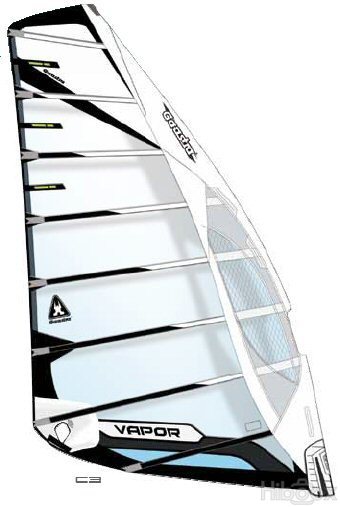
“Secret Weapon”
The 2010 Vapor more than surpasses its historic expectation of excellence. Designed around the demands of the best racers on the planet, Dan Kaseler has created the brainchild of Kevin Pritchard, Ross Williams, Arnon Dagon, and Cedric Bordes, each a living legend with irrefutable expertise. Gaastra R&D continues to move forward and upward, as 2009 PWA vice-slalom world champion and former speed world record holder Finian Maynard has signed on to race with the Gaastra 2010 International team.
This years Vapor underwent a complete overhaul. The Inset Clew shortens the boom, provides effortless acceleration, and higher performance in disturbed wind and choppy conditions. The Inset Clew provides automatic depower control in puffs, by allowing the battens to twist open behind the boom. Normally, in a gust the center of effort moves backward and the draft increases making the sail feel backhanded, and unwieldy. This invention stabilizes the draft depth and holds the center of effort forward keeping the power in your hands where it belongs.
Unlike competitors, our Inset Clew repositions the boom and center of effort without compromising the outline. This allows the battens above and below the boom to react to the automatic depower this feature provides. Keeping the area beneath the back of the boom prevents us from needing to put that area somewhere else. Furthermore, this helps maintain a low and easily controlled center of effort. A protective silica bead around the inside of the opening and a maintenance free mini-batten beneath it guarantee smooth shape and infinite longevity.
A new low aspect-ratio outline and fuller profiles maximize low-end performance and collaborate with the Inset Clew to make early planing a certainty without any sacrifice to topend speed. The 2010 Vapor features an improved finer entry and narrower head for certain control at top speed. Shape is more stable than ever as this model boasts a wider luff panel and a 5th camber (in sizes 6.7-12.0) to push shape control even higher.
A new neoprene boom opening fairing prevents the sock from filling with water and optimizes aerodynamics. A wider sock makes rigging and rotating easier than ever before. This iteration of the Vapor grew significantly in only one year and this is the best time ever to own one. The 2010 Vapor is the fastest sail around any racecourse and a certain route to the podium whether you race in the PWA or at your local beach.
The 2010 Vapor is available in a standard monofilm model as well as a high performance PWA registered Technora Laminate model. Constructing an already superior sail of this futuristic materiel raises it to the pinnacle of windsurfing technology. The 2010 Vapor TL remains entirely unmatched.
We designed the Inset Clew to take advantage of a shorter boom without compromising the sails aerodynamics. As sails generate lift, high pressure air from the windward side of the sail tends to move towards the lower pressure air on the leeward side as it clears the trailing edge. Because of this, air at the head of the sail tends to go from the windward side to the leeward side over the top of the sail creating a tip vortex. This vortex creates drag that slows the sail down. Competing brands achieve inward clew position by cutting away the leech and foot of the sail beneath the boom creating another wingtip vortex. We’ve designed the Inset Clew without cutting away any more than is necessary to fit the boom. The wind exits the trailing edge cleanly and no additional tip vortex forms.
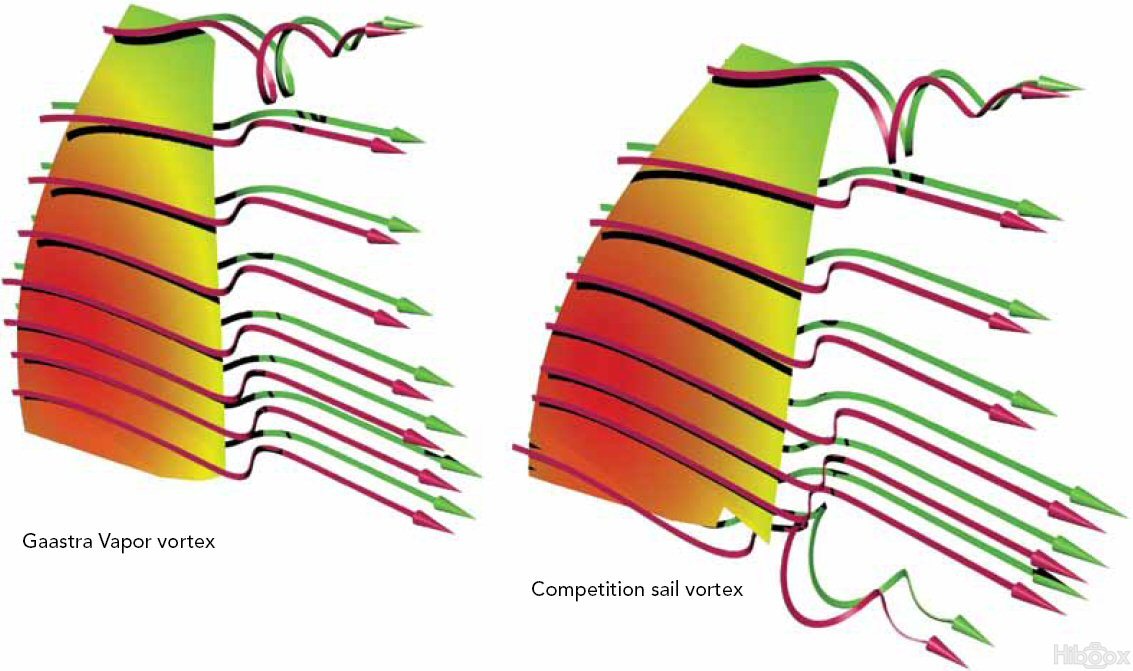

Interview with Dan Kaseler
Dan, this is a mighty impressive sail you have going here... tell us more about the new boom cutout and how it works!
You might wonder why the tail of the boom is really at the very top of the cutout hole when the sail is rigged, but not yet sailed.....it’s because when windsurfing the rider pulls down on the boom just by the nature of the way everything loads meaning when you are actually sailing, the boom is closer to the center of the hole at the boom. If you go for some negative outhaul, then the boom moves all the way near the bottom of the ‘inset clew’ hole so this cutaway space really serves a purpose.
This looks like technology that has not yet been seen before...
Yeah, we have been going crazy with this new creation! All the tricks are coming out of the bag! Check out the special nonremovable, non-adjustable mini batten that sits just below the cutout. It makes sure that the load is spread evenly and no wrinkles develop from the design. It is oriented parallel to the main battens, not parallel to the bottom edge of the cutout, as you might expect. This orientation makes sure that the sail can be comfortably rolled.
How about the number of battens and cams- looks like you have different numbers for different sizes?
Yes, I like to keep the proportions optimized for different luff lengths. The 6.7-12.0 all have 5 cams this year. This is up from 4 cams in 09. This ensures better profiles, especially near that top cam, where last year there was a bumpy knuckle on the leeward side of the sock.
Batten count is the same as last year....6.7-12.0 all have 8, while the smaller sizes have just 7.
So what can we expect from this new machine?
Well there is so much going on - all the team guys were asking for more acceleration, better top end, earlier planing.....we had a lot to accomplish so we stepped up to the plate and went to work. The new outline gives us more bottom end from the longer boom area (boom spec is shorter due to ‘inset clew’). The head is much narrower and this gives us better top end speed and control. We leaned out the entry and pushed the draft back - this has made a huge performance increase! The sails pump onto a plane, glide through the gusts and continuously accelerate!
What more can you ask for...
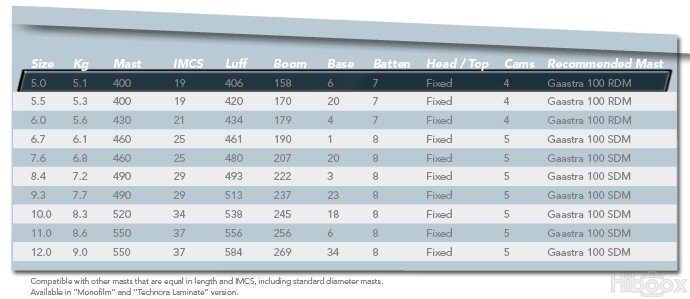
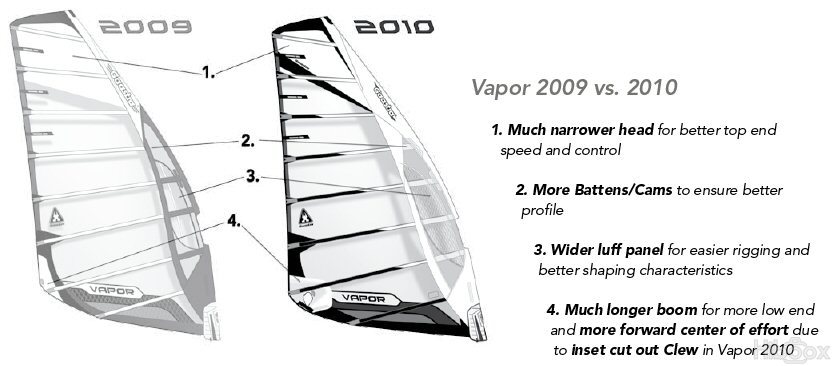
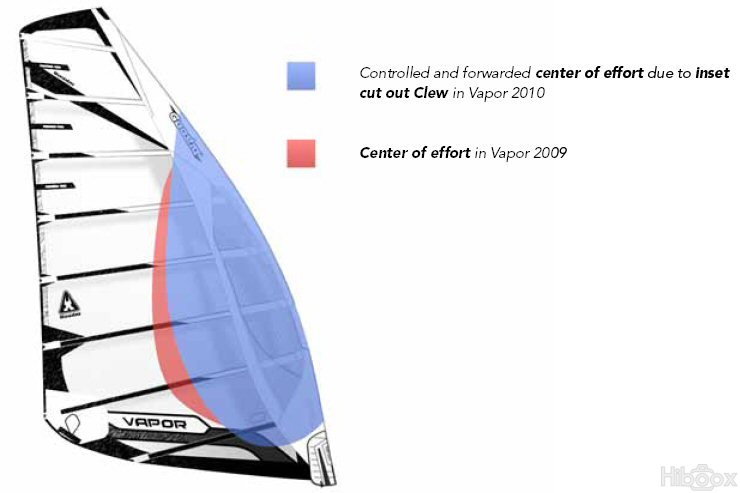
Design Development
• Unique Inset clew- shortens boom length while keeping the sail outline efficient and aerodynamic
• Wider luff panel for easier rigging and better shaping characteristics
• Wide sock technology
• Easy rigging snap on style
• New view windows tough luff socks for improved visibility
• Locked in cam shape for top end control
• Drop tack design for “closing the gap”
• Triangulated load bearing panel layout gives the most strength to weight ratio
:arrow: Gaastra Vapor 2010.pdf[url=http://www.windsurfing44.com/matos/Gaastra/2010/Gaastra_2010_Vapor_en.pdf][url=http://www.windsurfing44.com/matos/Gaastra/2010/Gaastra_2010_Vapor_en.pdf][url=http://www.windsurfing44.com/matos/Gaastra/2010/Gaastra_2010_Vapor_en.pdf][url=http://www.windsurfing44.com/matos/Gaastra/2010/Gaastra_2010_Vapor_en.pdf][url=http://www.windsurfing44.com/matos/Gaastra/2010/Gaastra_2010_Vapor_en.pdf][url=http://www.windsurfing44.com/matos/Gaastra/2010/Gaastra_2010_Vapor_en.pdf][url=http://www.windsurfing44.com/matos/Gaastra/2010/Gaastra_2010_Vapor_en.pdf][url=http://www.windsurfing44.com/matos/Gaastra/2010/Gaastra_2010_Vapor_en.pdf]

“Secret Weapon”
The 2010 Vapor more than surpasses its historic expectation of excellence. Designed around the demands of the best racers on the planet, Dan Kaseler has created the brainchild of Kevin Pritchard, Ross Williams, Arnon Dagon, and Cedric Bordes, each a living legend with irrefutable expertise. Gaastra R&D continues to move forward and upward, as 2009 PWA vice-slalom world champion and former speed world record holder Finian Maynard has signed on to race with the Gaastra 2010 International team.
This years Vapor underwent a complete overhaul. The Inset Clew shortens the boom, provides effortless acceleration, and higher performance in disturbed wind and choppy conditions. The Inset Clew provides automatic depower control in puffs, by allowing the battens to twist open behind the boom. Normally, in a gust the center of effort moves backward and the draft increases making the sail feel backhanded, and unwieldy. This invention stabilizes the draft depth and holds the center of effort forward keeping the power in your hands where it belongs.
Unlike competitors, our Inset Clew repositions the boom and center of effort without compromising the outline. This allows the battens above and below the boom to react to the automatic depower this feature provides. Keeping the area beneath the back of the boom prevents us from needing to put that area somewhere else. Furthermore, this helps maintain a low and easily controlled center of effort. A protective silica bead around the inside of the opening and a maintenance free mini-batten beneath it guarantee smooth shape and infinite longevity.
A new low aspect-ratio outline and fuller profiles maximize low-end performance and collaborate with the Inset Clew to make early planing a certainty without any sacrifice to topend speed. The 2010 Vapor features an improved finer entry and narrower head for certain control at top speed. Shape is more stable than ever as this model boasts a wider luff panel and a 5th camber (in sizes 6.7-12.0) to push shape control even higher.
A new neoprene boom opening fairing prevents the sock from filling with water and optimizes aerodynamics. A wider sock makes rigging and rotating easier than ever before. This iteration of the Vapor grew significantly in only one year and this is the best time ever to own one. The 2010 Vapor is the fastest sail around any racecourse and a certain route to the podium whether you race in the PWA or at your local beach.
The 2010 Vapor is available in a standard monofilm model as well as a high performance PWA registered Technora Laminate model. Constructing an already superior sail of this futuristic materiel raises it to the pinnacle of windsurfing technology. The 2010 Vapor TL remains entirely unmatched.
We designed the Inset Clew to take advantage of a shorter boom without compromising the sails aerodynamics. As sails generate lift, high pressure air from the windward side of the sail tends to move towards the lower pressure air on the leeward side as it clears the trailing edge. Because of this, air at the head of the sail tends to go from the windward side to the leeward side over the top of the sail creating a tip vortex. This vortex creates drag that slows the sail down. Competing brands achieve inward clew position by cutting away the leech and foot of the sail beneath the boom creating another wingtip vortex. We’ve designed the Inset Clew without cutting away any more than is necessary to fit the boom. The wind exits the trailing edge cleanly and no additional tip vortex forms.


Interview with Dan Kaseler
Dan, this is a mighty impressive sail you have going here... tell us more about the new boom cutout and how it works!
You might wonder why the tail of the boom is really at the very top of the cutout hole when the sail is rigged, but not yet sailed.....it’s because when windsurfing the rider pulls down on the boom just by the nature of the way everything loads meaning when you are actually sailing, the boom is closer to the center of the hole at the boom. If you go for some negative outhaul, then the boom moves all the way near the bottom of the ‘inset clew’ hole so this cutaway space really serves a purpose.
This looks like technology that has not yet been seen before...
Yeah, we have been going crazy with this new creation! All the tricks are coming out of the bag! Check out the special nonremovable, non-adjustable mini batten that sits just below the cutout. It makes sure that the load is spread evenly and no wrinkles develop from the design. It is oriented parallel to the main battens, not parallel to the bottom edge of the cutout, as you might expect. This orientation makes sure that the sail can be comfortably rolled.
How about the number of battens and cams- looks like you have different numbers for different sizes?
Yes, I like to keep the proportions optimized for different luff lengths. The 6.7-12.0 all have 5 cams this year. This is up from 4 cams in 09. This ensures better profiles, especially near that top cam, where last year there was a bumpy knuckle on the leeward side of the sock.
Batten count is the same as last year....6.7-12.0 all have 8, while the smaller sizes have just 7.
So what can we expect from this new machine?
Well there is so much going on - all the team guys were asking for more acceleration, better top end, earlier planing.....we had a lot to accomplish so we stepped up to the plate and went to work. The new outline gives us more bottom end from the longer boom area (boom spec is shorter due to ‘inset clew’). The head is much narrower and this gives us better top end speed and control. We leaned out the entry and pushed the draft back - this has made a huge performance increase! The sails pump onto a plane, glide through the gusts and continuously accelerate!
What more can you ask for...



Design Development
• Unique Inset clew- shortens boom length while keeping the sail outline efficient and aerodynamic
• Wider luff panel for easier rigging and better shaping characteristics
• Wide sock technology
• Easy rigging snap on style
• New view windows tough luff socks for improved visibility
• Locked in cam shape for top end control
• Drop tack design for “closing the gap”
• Triangulated load bearing panel layout gives the most strength to weight ratio

![wooooow [wooooow.gif] [wooooow.gif]](/foro/smilies/wooooow.gif)
![qmeparto [qmeparto] [qmeparto]](/foro/smilies/qmeparto.gif)
![saludo [saludo] [saludo]](/foro/smilies/saludo.gif)
![applaudit [applaudit] [applaudit]](/foro/smilies/applaudit.gif) De eso no te quepa duda ya que al no ser que seas un Maquina total y no estes en competicion creo que el 95 % de los que navegamos con estas velas no creo que
De eso no te quepa duda ya que al no ser que seas un Maquina total y no estes en competicion creo que el 95 % de los que navegamos con estas velas no creo que ![windsurfing [windsurfing.gif] [windsurfing.gif]](/foro/smilies/windsurfing.gif)
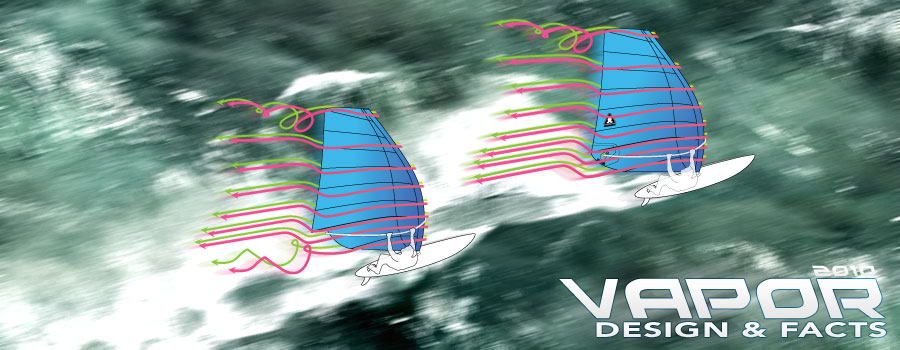
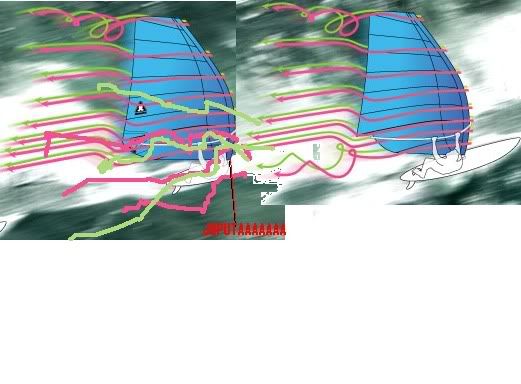
![meparto [meparto] [meparto]](/foro/smilies/meparto.gif)
![risas [risas] [risas]](/foro/smilies/risas.gif)